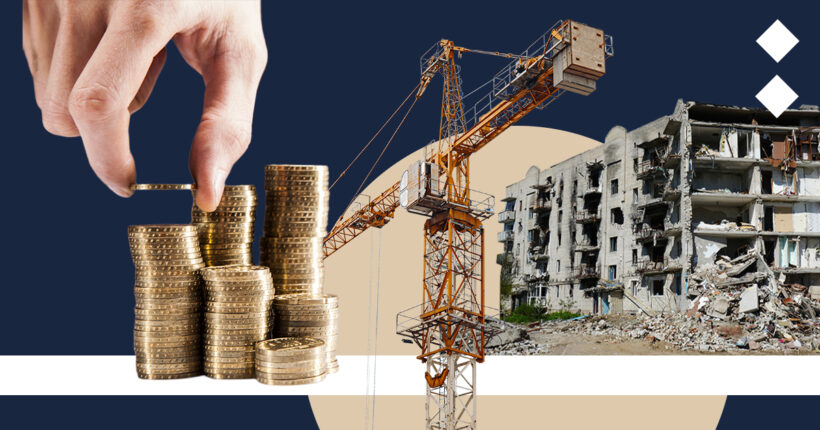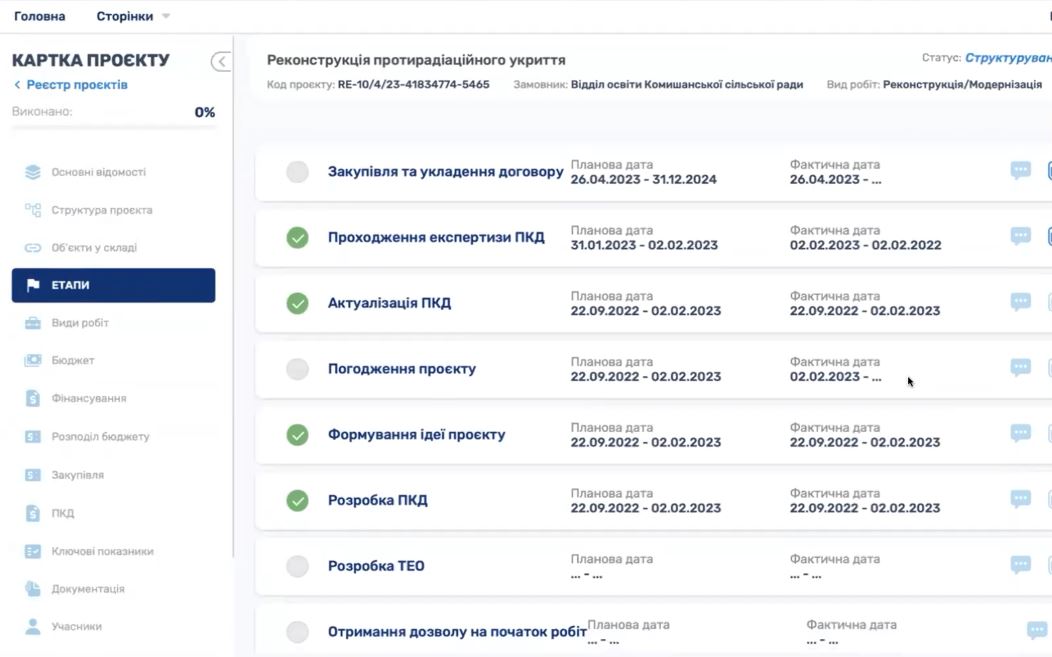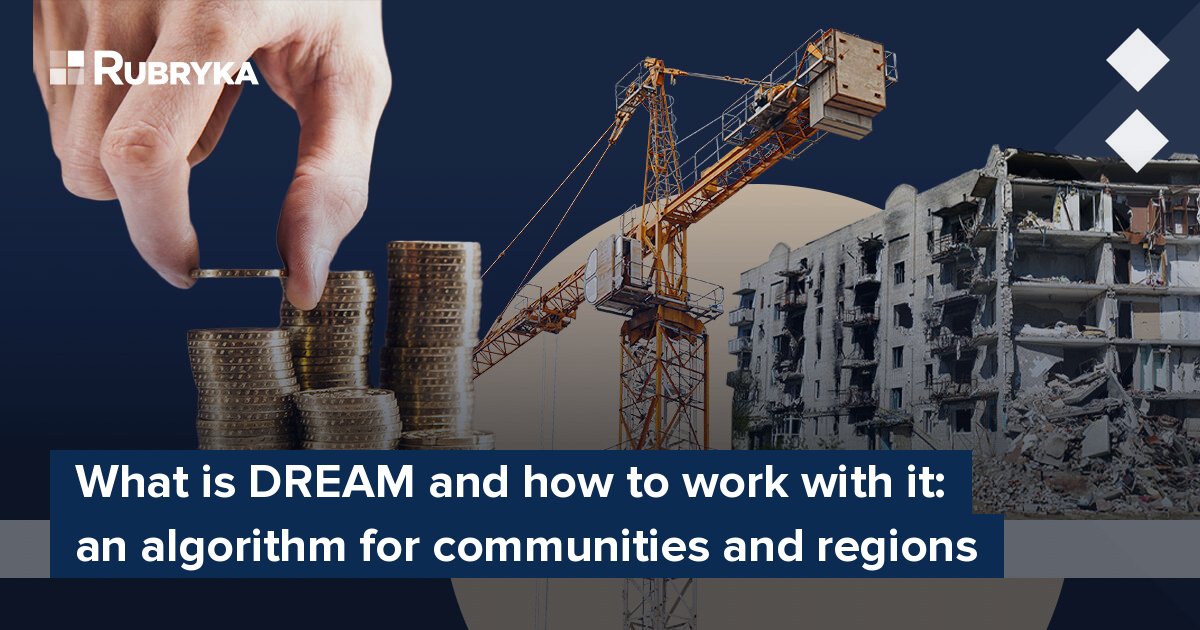
What is the problem?
Ukraine needs at least $411 billion for recovery
Due to the full-scale Russia'a aggression in Ukraine, almost 18,700 multi-story residential buildings and more than 144,000 private buildings need to be restored. As of May 2023, 1,451 objects of medical infrastructure and 1,520 objects of cultural infrastructure were damaged, excluding monuments of cultural heritage, of which almost a third — 541 — were destroyed.
As of February 24, 2023, the government of Ukraine, the World Bank Group, the European Commission, and the United Nations have increased the estimate of Ukraine's recovery needs to $411 billion. At the same time, investors and donors who are ready to support the restoration of Ukraine are afraid of corruption and lack of integrity in Ukraine.
What is the solution?
The Elimination Fund has funds for the first projects, but they will go only through DREAM
The Digital Restoration Ecosystem for Accountable Management, or DREAM, system was developed and launched in Ukraine — a digital ecosystem for accountable restoration management. It allows communities to submit their projects and show the stages of their implementation and results, and donors and the Ukrainian authorities to see where the funds are going.
"The DREAM system prevents corruption and manages the reconstruction process. It is important for us that communities use this resource daily, we have already included this tool in the working mechanism of the Fund for Elimination of the Consequences of Armed Aggression (Elimination Fund), and we will continue to work to ensure that this tool is end-to-end," says Oleksandra Azarkhina, Deputy Minister of Communities, Territories and Infrastructure Development of Ukraine.
The Elimination fund accumulates resources for recovery, and its processes are already digitized — precisely based on DREAM.
The first funds for implementing restoration projects in 2023 are already available. "Already ₴22 billion are on the way to finance the restoration of communities — a total of 381 projects. This is ten times less than we need, but it is an important step. Now we have a chance to prove to our partners that we can make reconstruction transparent and oriented to people's interests," Azarkhina said, addressing representatives of communities and regions.
Regional and local authorities submit projects for constructing and restoring multi-apartment buildings, medical facilities, schools and kindergartens, communal infrastructure facilities, and constructing protective civil defense structures precisely through the industry system based on the DREAM ecosystem.

On the screenshot: Front end part of the DREAM system
The team of the Ministry of Reconstruction conducted training for more than 700 listeners from all over Ukraine on how to do it correctly. Rubryka also visited it and spoke about the main points.
How does it work?
The back end part of the DREAM system is rebuild.gov.ua
Roman Komendant, Deputy Head of the State Agency for Reconstruction and Development of Infrastructure of Ukraine, explains: "As with any modern digital tool, the DREAM system has two directions: the public part (Front end), which displays all data and is available via the link, and the Back end part (rebuild.gov.ua), where responsible persons in each territorial community, restoration services, and customers enter data.

On the screenshot: Back end part of the DREAM system
How to enter?
After registration and with EDS or KEP
Access to this part of the system is granted only after filling out the registration form and having an electronic digital signature (EDS) or a qualified electronic signature (QEP).

On the screenshot: Login to rebuild.gov.ua is possible only if you have an EDS or QEP
The registration form can be obtained by contacting the monitoring department at +38 (063) 229 55 00, by texting this number via Viber or Telegram, or e-mail at support@restoration.gov.ua.
Support is available Monday through Friday, 9:00 a.m. to 6:00 p.m. You can also contact support with any questions that may arise during the completion of the project.
After filling out the registration form, users are divided by access rights: those who can enter data and those who can only view data. Both groups can download data from the system in Excel format.
In particular, representatives of territorial communities who submit projects will be able to enter data and edit it, and, for example, representatives of regional military administrations, whose duties include coordinating the process of providing projects by communities, will only be able to review.
After filling out the form, the user will receive a letter to the e-mail from which they registered and will be able to work in the system.
If, for example, a representative of the regional military administration also wants to register a project for an object of regional communal property, they should contact the support service at the above contacts to expand access options.
Also, several community members can register — the optimal number is five, but it can be more or less. All these people have to fill out the registration form, and the organization will unite them so they can work on the project simultaneously.
Where to start?
Add an idea or project to the register of project ideas
Anna Gubanova, an employee of the State Agency for Reconstruction and Infrastructure Development of Ukraine, explains that the system has a register of project ideas and projects. To add an idea or an approved project, you need to select the register of project ideas (not the register of projects!).

On the screenshot: to start a project or idea, you need to select the Register of project ideas
Next, select the button 'Create an idea' and fill in the necessary fields: name of the project, customer, type of work, location, socio-economic goal, description of the project, and availability of a feasibility study. A drop-down list works for many items, from which you only need to select the desired item.

On the screenshot: This is what the project idea filling page looks like
After filling it out, press the 'Create project' button.
If you submit an idea, it remains in the register of project ideas. You can submit any ideas, even those not selected for the Elimination Fund, Komendant notes. Project ideas will also be presented in the public part, that is, on the website dream.gov.ua, where donors and investors can see and finance the ideas that interest them.
If the project has already been approved and it has a feasibility study, project and estimate documentation (PED), or an order to start construction work, click 'For Approval.'

On the screenshot: This is how the project is approved
'Approve before design' is chosen when there is a feasibility study, PED, and 'Approve before execution' is an order approving the project for the start of construction work. It is also necessary to upload the available documents: the decision of the government, the regional council, and the decision adopted at the community level, which confirms that the project is approved.
"After that, your project will automatically be added to the project register," instructs Gubanova.
What's next?
Fill in the sections of the project
Then new, more detailed sections will open that you will need to fill out.
Each user will see in the system only those projects submitted by themself or projects of organizations subordinate to them. All user actions in the system can be verified.

On the screenshot: the project idea card
In the system, you can show: objects in the project, stages, types of work, budget, and financing of the project, purchases related to the project, and project and estimate documentation (it is better to download the PED in full, Komendant advises).

On the screenshot: Project card
If, for example, the desired organization or designer is not on the list, press the '+' key and enter basic information about them, then the support service will promptly add them to the list.

On the screenshot: Key indicators should be specified as basic and target
On the screenshot: It is also necessary to download all available documents for the project

On the screenshot: choose the role of the project participants from the drop-down list

On the screenshot: It is also necessary to download all available documents for the project

On the screenshot: choose the role of the project participants from the drop-down list
Project participants: the user of the object is the organization that uses it or will use it; the owner/holder — is the project holder; purchasing organization; the project initiator is the organization that creates and starts the project.
The 'Download Excel' button can be very helpful as it creates a document containing your entered information.
Projects should be submitted regardless of whose funds they are financed by. If the local budget fully covers the project, it must still be entered into the system.
In addition, through the DREAM system, communities must also report on recovery projects that are already being implemented. In particular, according to the results of the implementation of projects, it is necessary to conduct and publish on their official websites and enter the results of an audit performed in accordance with international auditing standards into the DREAM system.
How to find out the fate of the project?Functionality is still under development
"We want to ensure that the project is submitted to our system once from the community. The region sees it in the system and selects the projects it wants to submit to the Ministry. The Ministry already sees only those projects the region has approved," explains Komendant, deputy head of the State Agency for Reconstruction and Infrastructure Development of Ukraine.
Currently, the system cannot see which projects have been approved by the Ministry, but such functionality will be developed.
During the training, a question was raised: What kind of fight against corruption is this if projects are selected by a representative of the regional military administration, who may be involved in some way?
Komendant explains: "Earlier, you submitted a project to the region, and only you and the region knew about it. If you submit a project idea in the system, everyone will see it: the Ministry, any community, public activists, donors, and investors. Therefore, it will also be a tool of control over the region." In this way, bias can be exposed.
How will this solution evolve?
DREAM should be fully operational by the end of the year
The DREAM functionality will be updated in October 2023, and the system should be fully operational by the end of the year.
Then it will be integrated with the following:
- Register of damaged and destroyed property (RDDP);
- Geoinformation system of regional development (GIS), which is also planned to be launched by the end of the year;
- The unified state electronic system in the field of construction (USESFC);
- Branch reconstruction management system;
- Prozorro system;
- Spending.gov.ua — the only web portal for the use of public funds.
Then all the data users have entered into other systems will not need to be re-entered into DREAM — the data will follow the project automatically.
What else will this solution do?
A chance to attract funds from other investors
The Deputy Minister of Development of Communities, Territories, and Infrastructure of Ukraine, Azarkhina, emphasizes that DREAM is needed not only for the state to see all the objects of restoration but also for communities to have the opportunity to present their investment portfolios, talk about their needs and apply not only for funding from the Elimination Fund, the European Investment Bank but also private investors, and, in the future, structures, and funds of the European Union.
It will be recalled that at the Ukraine Recovery Conference held in London on June 21-22, 2023, it was announced that $55 billion would be allocated to support Ukraine. Therefore, a transparent tool for using these funds is just in time.








